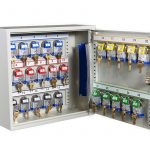Key cabinets are designed for the safe and convenient storage of keys, enabling them to be organised and identified quickly and easily. Bringing keys together in an appropriate key cabinet means they are located in one place, it is immediately clear which keys are there and can be found and managed easily.
There is a wide range of key cabinets on the market, from simple locking units to more advanced options and tracker systems for keys, covering domestic, commercial and industrial applications.
Securing keys in a key cabinet and ongoing key security are important issues for many businesses responsible for high-value assets such as vehicles, properties and even medicines.
In addition, there are some specific applications where key cabinets play a critical role, in particular LOTOTO (Lock Out, Tag Out, Try Out) where padlocks and keys are used to lock out and isolate machinery for service and repair, preventing accidental re-energising and danger to life.
For these applications, specialist suppliers also offer padlock cabinets and locking key cabinets. Designed to store different sizes of padlocks, many of these cabinets feature adjustable rails and widely spaced hanging hooks to accommodate different sizes of padlocks.
Many businesses have requirements to identify, store, locate and manage keys in a key cabinet, for example, car dealerships, estate agents, healthcare facilities such as hospitals and care homes, fleet management and car hire, long-stay car parks, hotels and other property-related businesses.
In addition, key and padlock security and key management systems are essential for many, including lockout tagout safety procedures.
Key Cabinet Buying Criteria
If you are considering buying a key storage cabinet, then your choice should be based on several factors, including proposed use, access method and location, and whether your needs will change into the future, as your business grows. Planning will ensure you get the best key cabinets to match your requirements in the future.
Size & quantity of keys for storage
How many keys will you need to store, and what size are these keys, typically? Different size key cabinets offer different capacities and numbers of hooks and will fit into specific spaces, so choosing the right size key cabinet is important.
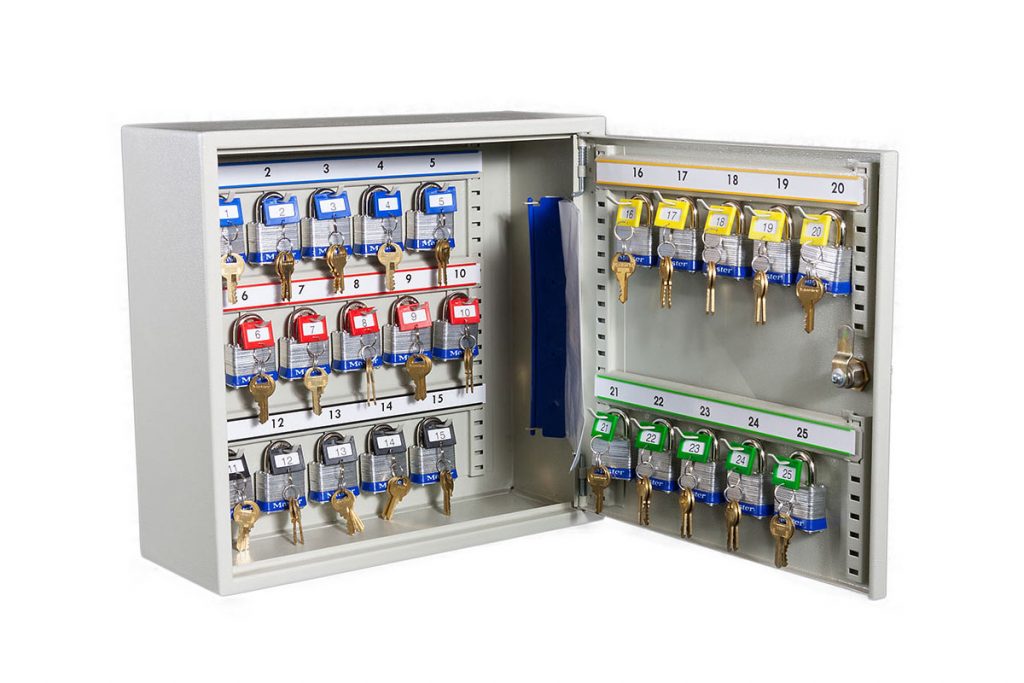
You may also want to consider a key cabinet with adjustable rails, which means you can store keys of different sizes on key hooks, or even an extra deep key cabinet if you need to store bunches of keys or more bulky keys with transponders, such as car keys.
Choosing a key cabinet with storage for keys inside on the back of the door will also mean you have the option to store a larger number of keys within a similar cabinet footprint, important if cabinet size is an issue from a location point of view.
Key cabinets are typically available with a key capacity of 50-500 key hooks. Alternatively, if you only need to store single keys or a small number of keys, a key safe or key box might be a more appropriate secure storage choice, commonly used with holiday rental properties and Airbnb. Outdoor key safes offer affordable and effective protection for applications with multiple users.
Construction
Key cabinets are usually manufactured from steel, commonly with a powder-coated finish.
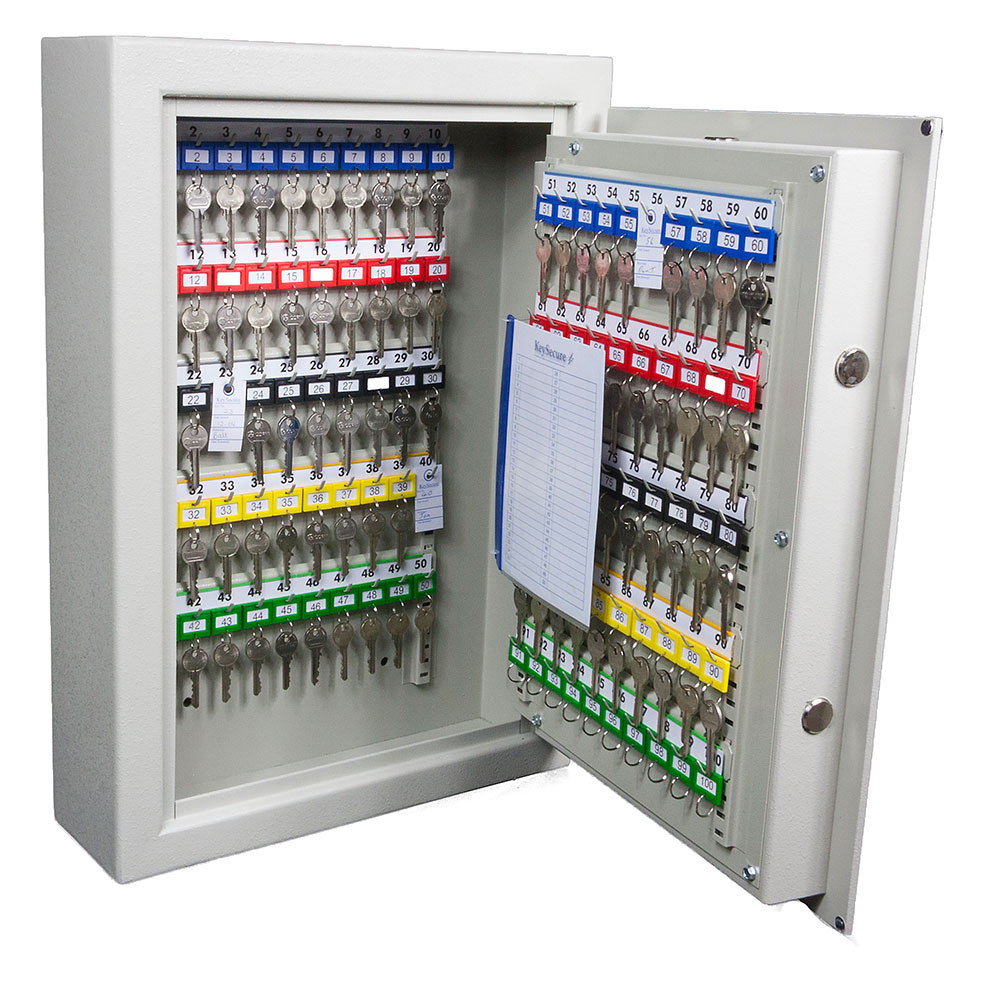
If your business caters for high-value or hazardous activities and the keys are of high importance, then securing them is even more critical. For more high-risk commercial applications, it may be necessary to select a high-security key storage unit manufactured using a stronger construction, typically 3mm thick steel with a 6mm steel door.
Lock type
Key cabinets are available with several different securing mechanisms, dependent upon levels of security and operational preferences. These include:-
- Key operated – a straightforward option enabling quick and easy access
- Combination lock operated – ideal for applications where regular changes to the access permissions may be required
- Electronic keypad locking – digital keypad capability usually up to 8 digits for security, battery operated. Electronic lock mechanisms can also provide an audit trail of those accessing them.
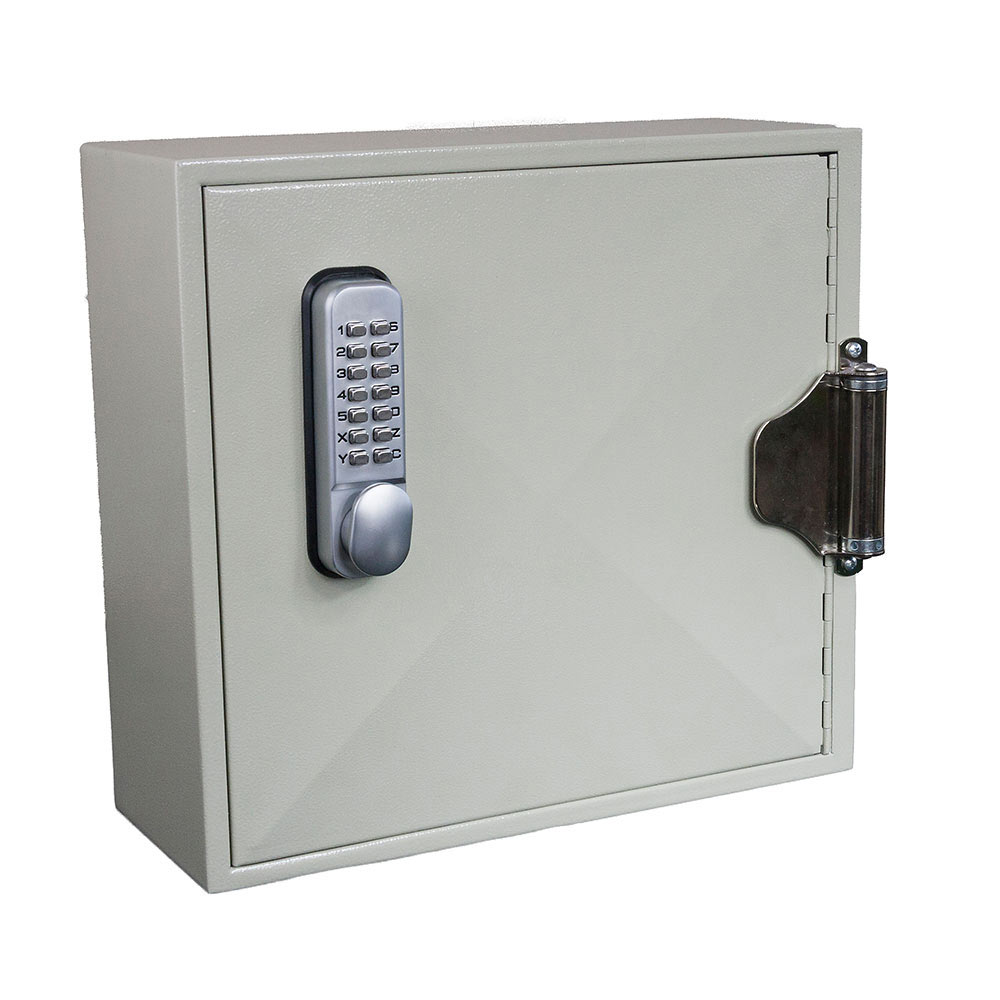
Different types of locks are also available, including double-bitted 8-lever safety locks for high-security applications. Double-bit keys have two bits or key cuts on the key stem, for added security.
Do you need to see the keys?
Different businesses and applications may need to be able to see the keys held in the unit when the cabinet is secured, to check at a glance whether a particular key is available. This can be particularly useful when access to the key cabinet is severely restricted for security purposes.
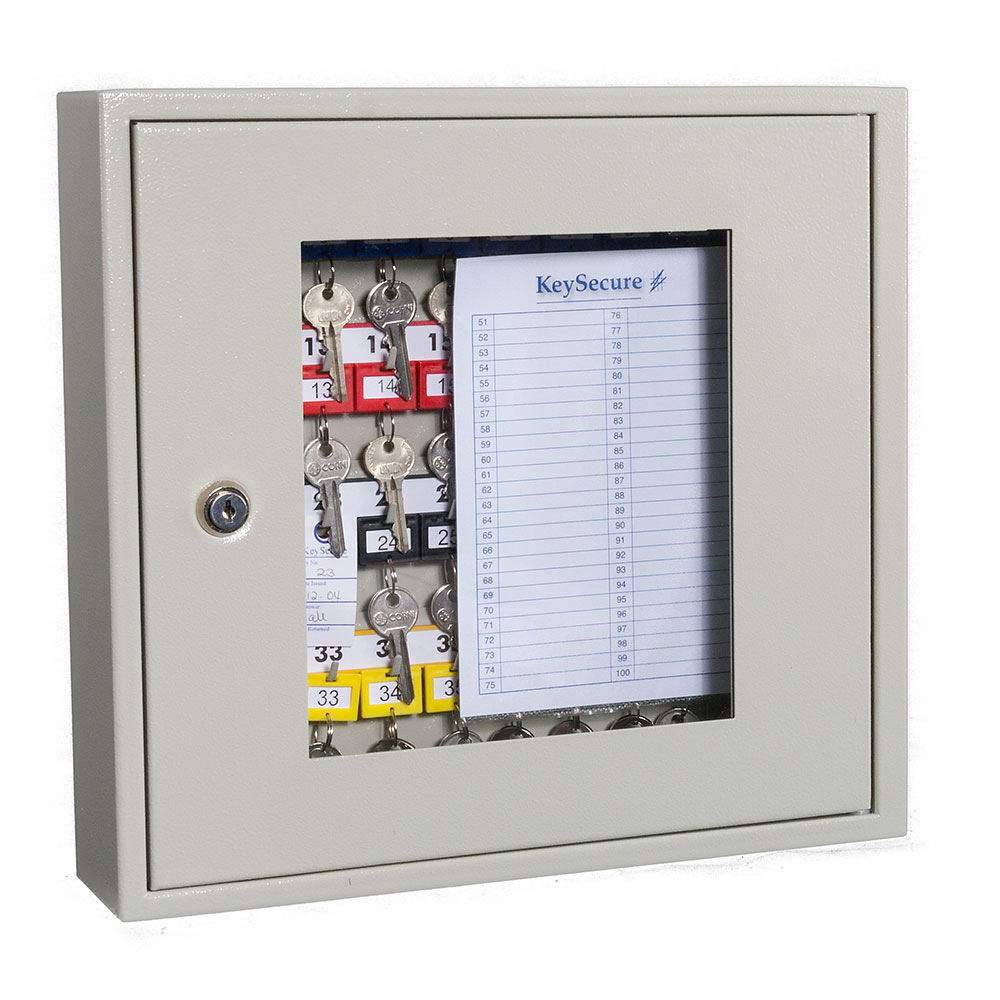
Key cabinets are also available with glass or Perspex panels in the door, enabling users to check and identify if a key is present without having to open the door. These glass fronted key cabinets are usually selected for high-security applications, but also prove useful anywhere fast and easy key identification may be useful.
Key view cabinets are typically used by hospitals to secure medicines, by car dealerships for vehicle keys and by estate agents managing properties.
Installation
It is also important to consider where your key cabinet will be located and installed. You will need to ensure it is easily accessed by those who need to use the keys but also provides a safe and secure location for these vital assets.
- Wall mounting – the most typical installation, in a convenient yet secure location to enable easy access. The most popular choice for commercial applications.
- In a niche or recess, wall mounted – here, the actual size and depth of the key safe cabinet will be an important consideration.
- Portable or mobile key safes – equipped with a carrying handle to allow access to and safe storage of keys on the move. Ideal for access to properties, for example for maintenance purposes.
Key Tracking
Once your keys are secured and organised in a defined location, in a key-safe cabinet, you may need your key management systems to go a step further so you are aware of who has each key at any defined moment in time. This is a vital consideration for applications such as lockout tagout, but can also be important and useful for other commercial uses.
Mechanical or electronic key tracking systems play an important role here. A key management system will identify who has taken possession of a key so it can easily be located if required, or can even determine who had a key at a certain time.
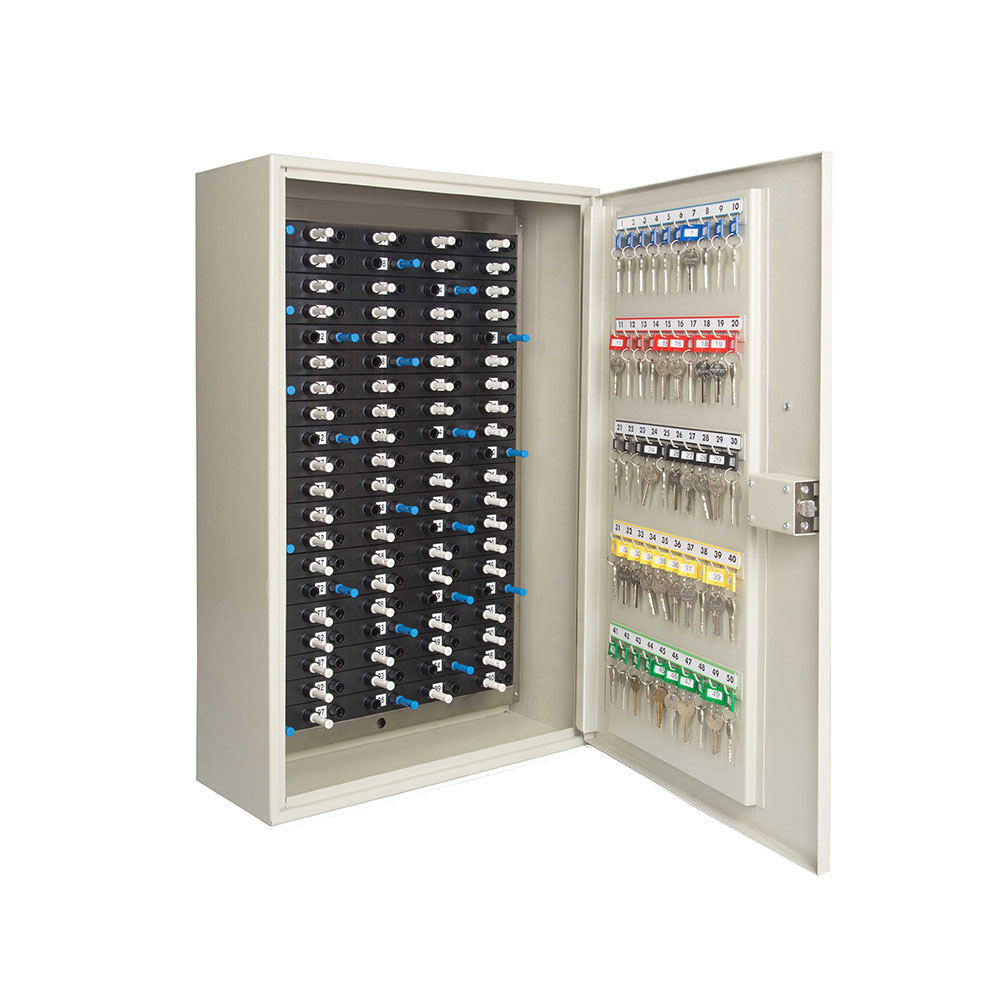
Mechanical systems use no power so are a simpler choice, with access pegs given to members of staff with access rights. These are used to remove keys or bunches of keys and remain in place until the item is returned. Often referred to as ‘peg in, peg out’ systems, they provide a useful control and management facility.
Electronic key tracking systems provide a more comprehensive solution for applications where large numbers of keys require management. These systems use different technologies such as RFID, access cards, PIN numbers or even fingerprint and facial recognition to securely control access to keys.
Key cabinets in the automotive industry
Key security, accountability and accessibility play a huge part in the smooth running of many car dealerships, garages, auction houses and service centres. Control of keys is important as modern security systems generally mean that the car can only be stolen with the keys. Lack of the above can prove costly as was the case with XYZ Motors.
XYZ Motors ran a busy service and MOT Testing Centre with a high number of vehicles passing through each day. Unfortunately, two vehicle keys were lost on one particular day and this was a regular occurrence with keys often getting mislaid in the past which had cost time and money. Had they been lost or stolen? Customers were delayed in collecting their vehicles whilst the workshop employees searched everywhere for the keys – not a reassuring service! An urgent solution to the wasted time and searching for the keys was needed.
Working closely with Reece Safety a solution was found. Not only to the immediate problem of key security but it was quickly seen as one to save time and money in accessing and accountability of the vehicle keys.
The Reece Safety range of automotive key security cabinets with the added benefit of a self-closing door was evaluated and found to be a cost-effective way forward with important features for a busy working environment.
The chosen option featured rugged square-cornered construction, and durable powder coating built to withstand a harsh environment and lots of use. The adjustable colour-coded key hook bars, to accommodate different lengths of keys, with corresponding numbered key tabs (each department having a different colour) make key organisation obvious when opened.
Strong metal hook bars were able to cope with the high usage with different lengths and spaced hooks for the alternative size of keys and transponders, ensuring there was no messy bunching, overlapping and tangling of keys.
In this instance, a self-closing key cabinet was installed. The internal control index (which is removable) was not used and keys were taken, signed out and logged in, in a separate ledger. The high-quality digital lock was supplied with a latch-closing function.
To complete the cabinet for the purposes employed it was then manufactured with a facility for the door to self-close, ensuring that the cabinet is never left open. The result was to keep the keys secure, accessible and accountable to authorised users only.
XYZ Motors found the Self Closing Key Security Cabinet a cost-effective solution to their key control problem, giving a more professional control of keys at any given time and saving money.
Key Cabinets in the Health Sector
Effective control, security and accountability of keys is of paramount importance within the Health System. Whether it be in a clinic, surgery or hospital environment, unauthorised access to any given area, must be prevented. The consequences of uncontrolled access can be devastating in the loss of materials and equipment resulting in delays in administering medication or, in extreme circumstances, loss of life.
Instances have occurred where cabinets have needed to be forced open as entry was required immediately. This has resulted in expensive repair or replacement costs. Other instances have resulted in the security of the keys being severely compromised – with doors left open to make things easier. The control, accountability and security of the keys had completely broken down and the often-priceless resources were left open to all.
A recent problem arose at the General Hospital in Southampton with accessing a set of key cabinets holding keys to highly sensitive medical record cabinets. Time was constantly being lost locating the authorised person responsible (keyholder) on the ward. An answer was required to enable the cabinets to be accessed without wasting valuable time and money whilst maintaining a high degree of security.
After evaluating several options a highly cost-effective solution was found by using the Reece Safety Key Control System fitted with a ‘stand-alone’ electronic digital lock with a key-override facility – as an emergency access in the unlikely event of a lock failure. A push-shut latch was fitted which ensured the door automatically closed every time, so no more doors were left open! Appropriate wards were fitted with this key storage solution. The flexibility of the cabinet met the requirements needed, to ensure keys were always securely accessible to authorised persons.
The ruggedly constructed cabinets have a durable powder-coated finish and coloured adjustable hook bars with corresponding coloured numbered key tabs which can be repositioned to suit different size keys. In this installation, different coloured hook bars/key tabs were used to denote the different areas e.g
WARD 1 – FITTED OUT IN BLUE
WARD 2 – FITTED OUT IN RED and so on.
Each cabinet was supplied with a control index, which when removed makes key identification/location virtually impossible. The lock itself offered all the features needed to maintain security procedures at the hospital; which was up to 80 user codes and 10 one-time user codes.
Also important was the ability for the lock to be reprogrammed whilst on the door and this proved particularly useful. No unnecessary expense was incurred in changing the codes when security protocol dictated. As a note, whilst not required immediately, there is a remote connection facility available on this lock, enabling a link to external switches or alarms. From an additional security view, there is a tamper-time-out and low battery warning.
Concerning keys, the wards ran more efficiently, had easy access at the appropriate times, adhered to the correct security protocols, no wasted time, no expensive repairs, no wasted money etc Budgets are very tight within the NHS and the pay-back period for this investment was estimated to be in the region of no more than 4 months from a cost saving but, of course, the effective use of time of these Health Professionals had a far higher value.
Key Cabinets in the Education Sector
Nurseries, schools, colleges, universities, and all places of learning are by their nature a hive of activity, with large numbers of people coming and going throughout the day and evening. In today’s environment, it is increasingly necessary to know who is entering and leaving, to ensure the safety and security of people and equipment inside. The theft of computers and printers is a common crime in this busy environment.
There are numerous access control systems in the market today, which can monitor and restrict the movement of people within the building and the same applies to keys within the building. There must be effective key control/security within the premises to prevent unauthorised access, preventing vandalism and theft, which can have devastating consequences. Not least the financial costs incurred, time lost in replacing expensive equipment, insurance premiums, projects delayed and physical harm, the potential list of costly time wasted is endless.
A Junior school (ABC) had a problem with unauthorised access to the IT storeroom which sadly resulted in vital equipment being taken. There was no control over who had access to the IT room so the lack of accountability resulted in no security. The outcome was suspicion, accusations, and delays in lessons, all with valuable time and money wasted. There were simply too many personally issued keys in circulation to the single site key cabinet holding the various equipment room keys. Nobody was sure who had one, how many ‘were out there’, so consequently zero accountability.
Recognising the need to find a cost-effective solution to improve the situation, they talked to Reece Safety who in this instance came up with a simple low low-security alternative. A Key Control System with an electronic digital cam-lock, providing 10,000 possible code combinations. The SECKS50 Key Cabinet is a strong square-cornered cabinet with a durable powder-coated finish.
Internally it is fitted out with 5 different coloured numbered hook bars with corresponding coloured numbered key tabs. The key tabs have been designed to hang showing at a glance the numbers – giving immediate recognition. The metal hook bars are robust and can be adjusted to suit different lengths/sizes of keys, ensuring a neat and visual identification within the cabinet. An index card relates to the numbers and this is removable when the cabinet is left unattended thus making key identification/location virtually impossible. Key Locations cards can be used when a key has been taken, until returned, to show where the critical keys are once removed. This simple system ensures control and check of the key within the system at all times.
Control was regained immediately. Only authorised users had access which enhanced internal security. There were no lost or duplicated keys in circulation and digital access codes were changed periodically for security protocols or when a member of staff left. No expensive changing of locks or issuing new keys was then needed. The Key System provided a solution to this Junior school’s problem of key control, accessibility and security in a cost-effective manner.
Wrapping up
Choosing the right key-safe cabinet solution will be dependent upon the requirements of your business, the number of keys you need to control and how secure you require access to be.
With a wide choice on the market, from simple key safes to digital access key cabinets capable of holding up to 500 keys and featuring sophisticated key tracking systems, selection and specification can be a challenging issue.
Take a closer look at the range of locking key cabinets available from Reece Safety.
Frequently Asked Questions about Key Cabinets
Key cabinets come in a range of designs depending on the number of keys you need to manage and the level of security required. Reece Safety supplies high-security key cabinets, deep key cabinets for bulkier keys, and padlock cabinets.
Start by counting the keys you manage today and then consider future growth. Reece Safety offers cabinets from 20 hook units up to 600 hook systems to suit facilities, contractors, and industrial sites. You can browse all options in our key cabinet collection to find the ideal size and configuration for your application.
Yes, our key cabinets include strong steel construction and secure locking options such as cam locks, combination locks, and key-locking systems. For environments requiring stricter control, such as maintenance or isolation procedures, we supply lockout/ tagout equipment and cabinets designed for managing padlocks and permit keys safely.
 UK
UK US
US










